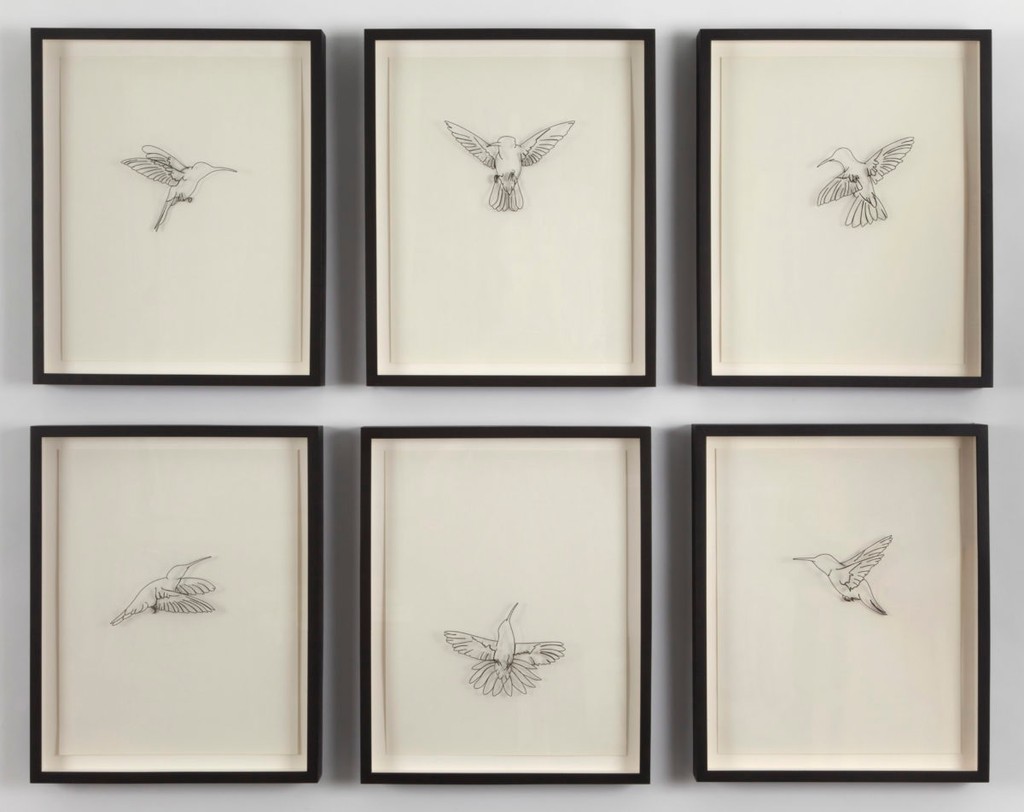I wanted to elaborate more on the concept of ‘transcendence’
by Paula Nishijima
Image: ‘Hummingbirds’ (Installation of 6), 2016, by artist Eric Rhein
I wanted to elaborate more on the concept of ’transcendence’, mostly because I have some reservations about it. BUT, the fact that HIV is a disease that you live with took me to the place of transcendence. I departed from Eric’s work and paid especial attention to it. The aesthetics of the drawings helped to describe such transcendence in the LTIH project. (more about it later)
[…]
For me, the starting point for a reflection about HIV and stigma is to re-situate us in what it means to be ‘healthy’ and what it means to be ‘ill’. I’d talk in terms of health ’state’ rather than ’status’, meaning that state entails more than the exclusively physical condition of a body. ’Status’ objectifies, quantifies and causally determines the body—thus, allowing the commodification of it—, creating a sort of ‘snapshot’ of an organism. A body is certainly an organism and, as such, it is its dynamic properties that make our (changing) existence possible. I want to consider existence as ‘being-in-the-world’ in a joint project, so ‘being-in-the-world-with-others’.
I turned to a book called Existential Medicine (2018), which interrogates the current/dominant view on health and illness within medical thinking. I thought of what Todd told about the meds and how the impersonal and instrumental framework of the health system treats/control bodies reinforcing the stigma of certain diseases like HIV (I’m generalizing, but I do think that medical thinking reinforces stigma 90% of the time, including when it manipulates genes to design enhanced bodies like Lulu and Nana)…
In one of the texts, which uses HIV as example (I’ve attached the article), the authors argue that our current model of medicine/health system does not acknowledge the existential character of the human body, ie. the human body as expression of its intersubjectivities and the fact that a body is not only an organism, but also the means of one’s existence, in the sense that a body is the existence of an experiencing subject. This phenomenological approach goes together with the necessity of treating the ‘person’ and not only consider the reductive view of the body as detached from the context of mutual existence in the world.
[…]
After all of this, I tried to be more objective and start to write a ’statement’ by raising the questions:
What is Luv ‘Til It Hurts?
It is when virtual pasts and futures are erased from a lifetime and what remains is a thin stroke of obliterating gestures. This is the trail of a new existence. The thinnest part through which life can be recognized. It is the abbreviation of the normative and the construction of a spatiality dedicated to the encounter of stigma and love.
Why the body?
The body is forgotten in a state of health. When a disruption occurs in the body, it rapidly changes our awareness of it.
What is the duration of an epidemic? How does a never-ending-epidemic look like?
Epidemics draw on the concept of being ill. Every disease is a disruption in the balance of a body and, more importantly, this ill body disturbs the normative context of the other bodies and their shared functions in public life or in a society.
Despite the fact that HIV evolves from the inside, the narratives of sickness develop from the outside, although an environment comprises of both. LTIH addresses the comprehension of a body beyond its organic, ‘causally determined entity in the physical world’, but as an imbroglio of metabolic exchanges between inside phenomena and outside circumstances.
Proposition of a framework for transcendence
What is transcendence?
Transcending is the impossibility of living in one of the poles of dichotomies like life and death, health and illness.
Much of the stigma on HIV still resonates the death sentence that comes with the diagnosis—even if today we can speak about preventive methods and treatment and an undetectable viral load… living with HIV expresses more than being alive or dead.
Is transcending an escape? No, transcending is to open a breach in the stiff portion of soil underneath our feet. The middle is not something in between, but it is produced by the impossibility of living in one pole of a dichotomy. It is not to be an actual object or subject of something, but the very process of subjectification.
It is to transform memory into future-making and what comes next into one more thread to bind. It is to stay with the contour of things, instead of reinforcing the contrast of positive and negative sides (Eric’s work).
Am I proposing a sort of immanent transcendence? Maybe…


